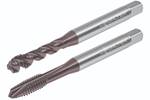Synchronized Tap Adaptor Increases Tool Longevity
The Walter AB735 synchronized threading insert compensates for axial movement, increasing tool life and lowering inventory costs.

Photo Credit: Walter USA
The AB735 synchronized tapping adaptor from Walter USA compensates for axial movement and pressure during tapping, allowing users to increase threading productivity while simultaneously increasing tapping tool life. As the synchronization of a machine, (i.e., the rotation of the spindle in relation to the feed) is one of the main reasons for tool wear in thread production, the AB735 Walter offers a flexible solution which minimizes the axial forces that occur during this process.
Used in all common ER collet chucks, the cost-effective adaptor ensures the requirement of very few tools. The sleek, short, compact design enables use in tight spaces, and thread flank wear is minimized as a result of less strain while chamfering.
Further, the AB735 synchronous threading adaptor maximizes tool performance. In addition to the minimized wear, the modular design of the adaptor also contributes to cost-efficiency; exchangeable front pieces for different thread sizes or tool diameters (ER16 to ER32) can be used with the same collet. Additional benefits include low maintenance requirements and a high level of process reliability, reducing the risk of breaking the threading tool.
Walter offers the quick-change system for all tool types with or without internal coolant. The AB375 accommodates internal coolant of up to 725 psi (50 bar), as well as external coolant supply. It is well suited to applications in the series production of threads and/or applications where lack of synchronization results in a high tool wear rate.
Related Content
-
The Secrets to Hard Milling Success
The Secrets to Hard Milling Success
-
6 Ways to Optimize High-Feed Milling
High-feed milling can significantly outweigh potential reliability challenges. Consider these six strategies in order to make high-feed milling successful for your business.
-
Treatment and Disposal of Used Metalworking Fluids
With greater emphasis on fluid longevity and fluid recycling, it is important to remember that water-based metalworking fluids are “consumable” and have a finite life.








.png;maxWidth=300;quality=90)



